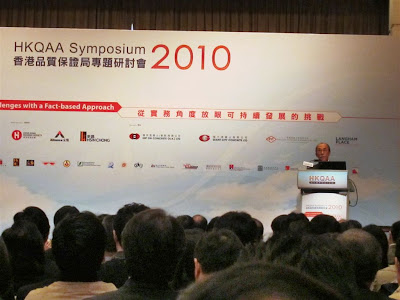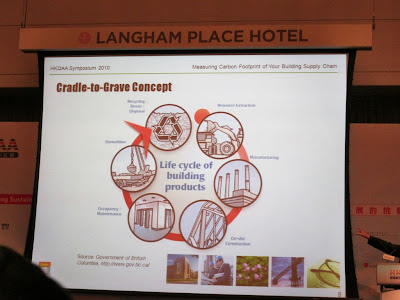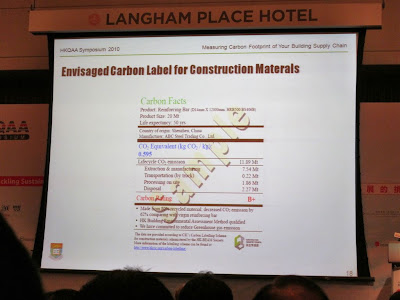The symposium’s frame entitled “Tackling Sustainability Challenges with a Fact-based Approach” and I summarized it below for sharing.

Morning Session – Building Towards Sustainability
Ir. Prof. Peter K.W. Mok (Chairman of HKQAA) gave a welcome speech. He introduced CSR and ISO 26000.

Then Mr. Che Wenyi (Vice Administrator, Deputy Secretary of the Party Committee Certification and Accreditation Administration of the People’s Republic of China) gave an opening speech. He introduced the testing and certification industry in China and its’ importance.

Prof. Mok presented a souvenir to Mr. Che.

Ms. Janet Wong (JP, Commissioner for Innovation and Technology, the Government of the HKSAR) gave an opening speech. She briefed the development of testing and certification industry in Hong Kong and introduced part of HKCTC report.

Prof. Mok presented a souvenir to Ms. Wong.

Group Photo of Officiating Guests

The first speaker was Mr. Sheng Fei (Director General, Department of Accreditation Supervision Certification and Accreditation Administration of the People’s Republic of China) and his topic was “Special Requirements of Construction Quality Management System Certification in China”.
He pointed out that there had many problems even though most of building and construction companies were registered by ISO 9001 certification, indicating the lack of effectiveness and efficiency on the implementation of ISO 9001. There were three main problems. First problem was that industries did not understand the requirement. Second problem was that they were not focused on “Quality”. And third problem was the monitoring of certification bodies.

The second speaker was Mr. David Dumigan (General Manager – Project Management Department, Henderson Land Development Company Limited) and his topic was “Value of a Sustainable Building”. He introduced the vision of Quality and the Environment of his company and showed an introduction video. His talk separated into following parts:
i) Quality – Indoor Environmental Qualities, Air, Daylight, Views, Acoustics
ii) Resources – Energy Flows & Energy Futures, Material Use & Water Consumption, Waste Management & Pollution Control
iii) Sustainability
iv) Innovation

Case – Indoor Daylight

Case – Reducing the consumption of energy

Case – Reducing the consumption of fresh water

Case – Energy efficiency water cooled AC system (30% energy saving)

Case – Comparative lower constructive cost

Brand Mark: Proudly Made in China.

Mr. Jacky Ip was the third speaker, who is Director of Property Management in Hong Kong Housing Society, and his speech entitled “Voluntary Assessment – Gaining Recognition from Future Mandatory Building Inspection”. Firstly, he briefed the management portfolio of Hong Kong Housing Society.

The building joined the Building Management and Maintenance Scheme (BMMS) before and after situation.

Then Mr. Ip introduced some new schemes called Mandatory Building Inspection Scheme (MBIS) and Voluntary Building Assessment Scheme (VBAS)


The objectives of the new schemes were:
· To advocate the best practice for continuous building management & maintenance and to nurture a building care culture in the community.
· To develop certification scheme for quality building management
· To gain recognition by BA so that a VBAS assessed building will not be required to go through MBIS.
The diagram showed some participating bodies.

Table summarized the key features of MBIS and VBAS

Assessment Categories between MBIS and VBAS

The certifications of both schemes were showed

The benefits of certification were got the recognition by BA through professional assessment so as to enhance property image.
Mr. Ip said the way forward was to train and register of VBAS assessors, as well as, to provide publicity & public education programmes for VBAS. The target would be set in mid-2011.
Dr. Thomas S. Ng (Associate Professor, Department of Civil Engineering, The University of Hong Kong) was the forth speaker and his presentation title was “Measuring Carbon Foot print of Your Building Supply Chain”.

Dr. Ng said “Building sector has an undeniable role to play in emission reductions” which based on the Kyoto Protocol and Hong Kong’s Target (to reduce carbon intensity by 50-60% by 2020 compared with 2005 levels).
The diagram showed the relationship between building lifecycle and whole life emission (Carbon). It demonstrated how import of the decision in the early project stage.

Then Dr. Ng. introduced “Gradle-to-Grave Concept” to us. It defined by Inventory of Carbon & Energy (ICE, 2008) that “The embodied carbon of a building material can be taken as the total carbon released over its life cycle.
This would normally include (at least) extraction, manufacturing and transportation.
Ideally the boundaries would be set from the extraction of raw materials until the end of the products lifetime (including energy from manufacturing, transport, energy to manufacture capital equipment, heating & lighting of factory, maintenance, disposal, etc.)”

The following table showed the embodied carbon of common building materials.

Dr. Ng stated many countries produced inter-industry specific datasets that knew as “Top-Down Approach”.

On the other hand, relevant standards such as ISO 14000 series, to be “Bottom-Up Approach” was discussed.

Then Dr. Ng introduced one of his study was “Envisaged Carbon Label for Construction Materials”. It could be putting Hong Kong at the forefront of sustainable development as well as accreditation service and carbon auditing.

The fifth speaker was Mr. Leo Wong (Assistant General Manager – Property Management, Kai Shing Management Services Limited) and his topic entitled “Showcase of Building Carbon Emission Reduction Projects”.

Mr. Wong introduced the Leadership of Energy and Environmental Design (LEED), which was developed by the US Green Building Council, and KCC is the 1st building obtained LEED certificate in Hong Kong. There were 8 key areas of human and environmental health in the LEED. They were “Location and Planning”, “Sustainable Site”, “Water Efficiency”, “Energy and Atmosphere”, “Materials and Resources”, “Indoor Environmental Quality”, “Innovation and Design Process” and “Regional Priority”. KCC was the LEED Project and got the good result on energy saving.

One of drawbacks of green building was very high initial construction cost.

Lastly, Mr. Wong shared the analysis of whole-life costing of this LEED project. He concluded that the “Whole-building approach” in LEED was the new idea in Hong Kong. KCC project may be a role mode of green redevelopment.

The last speaker was Mr. Sean Gilbert (China Director, The Global Reporting Initiative) and his topic was “Key to Sustainability Reporting in the Construction and Real Estate Sector”.

Mr. Gilbert showed the increasing of CSR reports in Chinese from 2001 to 2009.

Then he pointed out several benefits form CSR reporting. CSR reporting was a management process which linked with stakeholder engagement.

Then he briefed the development process to launch Construction & Real Estate Sector Supplement (CRESS).

Mr. Gilbert showed their own reporting to us.

Panel Discussion was performed at the end of Morning Session of the symposium by Dr. Ali Al-Zubaidi (Managing Director of Integrated Management Systems Associates Limited).
Reference:
www.hkqaa.org
www.globalreporting.org

沒有留言:
發佈留言